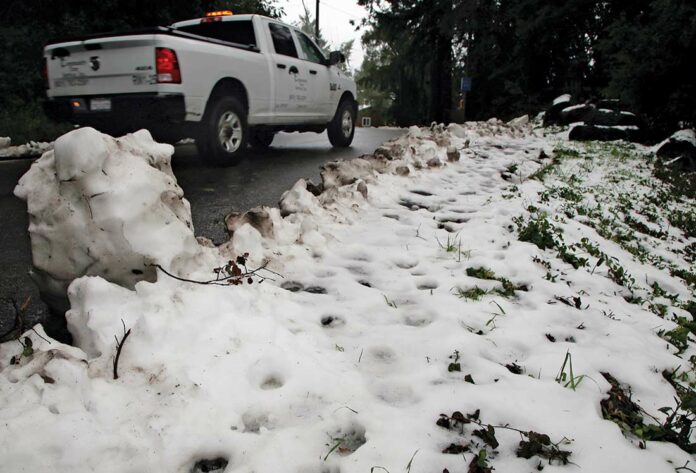The state’s continuous stormy weather is only making California’s large snowpack even larger, state water officials confirmed during their third snow survey of the year.
Combined with the series of winter storms that hit California in December and January, recent storms have given the state an above-average snowpack.
Results from the state’s latest manual snow survey, conducted on March 3, recorded 116.5 inches of snow depth at the Sierra Nevada’s Phillips Station, which is 177% of average for the area at this time of year.
The California Department of Water Resources’ electronic snow sensors throughout the state detected that the snowpack’s snow water equivalent is 44.7 inches, which is 190% of average for March 3.
“Thankfully the recent storms combined with the January atmospheric rivers have contributed to an above-average snowpack that will help fill some of the state’s reservoirs and maximize groundwater recharge efforts. But the benefits vary by region, and the Northern Sierra, home to the state’s largest reservoir Lake Shasta, is lagging behind the rest of the Sierra,” DWR Director Karla Nemeth said. “It will also take more than one good year to begin recovery of the state’s groundwater basins.”
Santa Clara County has been downgraded from “Moderate” drought to “Abnormally Dry,” the least intense level of drought measured by a federal drought monitoring program.
Meanwhile, 17% of California is now considered drought-free following the U.S. Drought Monitor’s latest report on March 2.
The U.S. Drought Monitor is produced by the National Drought Mitigation Center at the University of Nebraska-Lincoln, the National Oceanic and Atmospheric Administration and the U.S. Department of Agriculture.
A year ago, the entire county was considered in “Severe” drought, according to the monitor.
Water officials said that with one month left in the state’s wet season, they are closely monitoring spring runoff scenarios to maximize state water supply and prevent flooding.
As of March 6, the Uvas Reservoir west of Morgan Hill was at 101% of capacity, according to Valley Water data, while further north, the Chesbro Reservoir stood at 97%.
Valley Water Board Chair John Varela called the snowpack survey “encouraging.”
“With more storms in the immediate forecast, this could end up being one of the largest snowpacks in decades when the final survey takes place around April 1,” he said. “The Sierra Nevada snowpack is a critical piece of Santa Clara County’s water supply. More than half the water used in our county originates in the Sierra Nevada, and our reliance on that source of water is even greater with Anderson Reservoir out of commission while we rebuild the dam.”
Varela said in the coming weeks, the Valley Water board will evaluate the county’s water supply. Decisions on modifying outdoor watering restrictions will only be considered when the wet season is over, he added.
He cautioned that although the county’s groundwater levels have increased in some areas, others remain lower than before the drought.
“We know that our climate is only getting hotter and drier, leaving us with less water,” Varela said. “That’s why it’s important to make water conservation a way of life in Santa Clara County.”
“The recent storms over the past week broke a month-long dry spell in a dramatic way,” said DWR’s Snow Surveys and Water Supply Forecasting Unit Manager Sean de Guzman. “We are hopeful that we will see more cold storms to add to our snowpack for the next month and help set up a long, slow melt period into spring.”
For information on the drought monitor, visit droughtmonitor.unl.edu.
Copyright © 2023 Bay City News, Inc.










